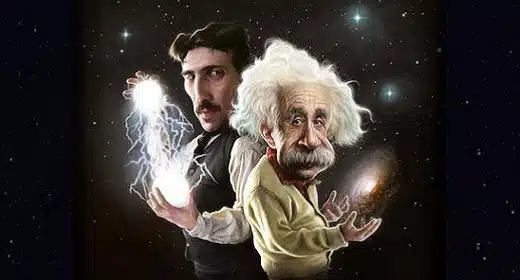by Arjun Walia: Things have drastically changed since Galileo was placed under house arrest for his scientifically accurate views, simply because they threatened the beliefs put out by the Catholic Church at the time…
Today, things have changed, to an extent. We still have information that is heavily controlled by the global elite. This small group of people and the corporations they run practically control all aspects of our lives, from media and finance to healthcare, education, and more. Most importantly, they control all of the information we see and read, whilst labelling everything else as ‘fake news.’ It’s a good thing this isn’t considered a conspiracy theory anymore, because if it were, we’d be in big trouble. Eisenhower warned us about the potential of “misplaced” power that would severely undermine American democracy. JFK warned us about the fact that there are those who wish to capitalize on an announced need for increased security, and that it would be “seized upon by those anxious to expand its meaning to the very limits of censorship and concealment.” Today, some historians estimate that the U.S. government classifies trillions of new pages of text every single year.
Things are different in the sense that the religious and spiritual communities are much more open to information and evidence that help us to understand the true nature of reality. Many religious and spiritual teachings are actually being confirmed by science, and that is evident by the list below. Take, for example, the Dalai Lama. He’s never been a stranger to science, and throughout his leadership he’s constantly advocated for the collusion of science and Eastern philosophy.
As Vice News points out:
This intersection of interests was manifest in the diversity of His audience, which was comprised of roughly 150 Tibetan bhikkhus, academics, and students who had piled into the conference center at Jawaharlal Nehru University to listen to the Dalai Lama and a panel of physicists and monastic scholars discuss the intersection of quantum physics and Madhyamaka Buddhist philosophy.
It’s truly amazing, especially in the fields of neuroscience and quantum physics, just how much knowledge our ancient cultures had regarding the true nature of reality. In many cases, modern day science is in fact catching up to this ancient knowledge. Personally, I believe science can take us far, but only so far, as we are burdened today by scientific dogmas and an industry plagued by corruption.
Non-Material Science
“Despite the unrivaled empirical success of quantum theory, the very suggestion that it may be literally true as a description of nature is still greeted with cynicism, incomprehension and even anger.”
– T. Folger, “Quantum Shmantum”; Discover 22:37-43, 2001
Non-material science began to emerge at the turn of the nineteenth century when physicists started to explore the relationship between energy and the structure of matter. When they did this, the belief that a physical, Newtonian material universe was at the very heart of scientific knowledge was abandoned, and the realization that matter is nothing but an illusion replaced it. The very make-up of an atom is comprised of what we believe to be empty space. At this point, scientists began to recognize that everything in the universe is made out of energy, and this has been known in the scientific community for more than one hundred years.
“Some materialistically inclined scientists and philosophers refuse to acknowledge these phenomena because they are not consistent with their exclusive conception of the world. Rejection of post-materialist investigation of nature or refusal to publish strong science findings supporting a post-materialist framework are antithetical to the true spirit of scientific inquiry, which is that empirical data must always be adequately dealt with. Data which do not fit favored theories and beliefs cannot be dismissed a priori. Such dismissal is the realm of ideology, not science.”
– Dr. Gary Schwartz, professor of psychology, medicine, neurology, psychiatry and surgery at the University of Arizona (source linked below)
Although scientific methods based upon materialistic philosophy have contributed much to our world, this philosophy has dominated the world of academia to the point that it has restricted the sciences from exploring other models and prevented the equal study of mind and spirituality. When we discovered phenomena that could not be explained by classical physics, it led to the development of quantum mechanics. This introduced the concepts of energy, frequency, emotions, feelings, thoughts, beliefs, and consciousness. It’s since been discovered that these concepts play a vital role in what we refer to as the physical material world today.
“The day science begins to study non-physical phenomena, it will make more progress in one decade than in all the previous centuries of its existence.”
The points made here summarize the problem with not recognizing, acknowledging, and examining phenomena that go past the borders of the physical material world. These points were co-authored by Dr. Gary Schwartz of the University of Arizona, Dr. Mario Beauregard of the University of Arizona, and Dr. Lisa Miller of Columbia University. It was presented at an international summit on post-materialist science, spirituality, and society.
**** The Summary Report of the International Summit on Post-Materialist Science, Spirituality and Society can be downloaded here: International Summit on Post-Materialist Science: Summary Report (PDF).
As far as spirituality is concerned, the idea that you can control your thoughts, feelings, and emotions, and use them to manifest your reality, is commonplace. The existence of “Chi” or “Prana” from ancient Eastern traditions both acknowledge this non-material world. Also known to some as the “Akash” or “Aether,” or that from which all comes. The primary source of creation in these realms is non-physical forces that our senses cannot identify, but modern day scientific methods can.
“The aakaash is not destructible, it is the primordial absolute substratum that creates cosmic matter and hence the properties of aakaash are not found in the material properties that are in a sense relative. The aakaash is the eternally existent, superfluid reality, for which creation and destruction are inapplicable.”
– Paramahamsa Tewari, engineer, physicist and inventor.
“And they allowed Apollonius to ask questions; and he asked them of what they thought the cosmos was composed; but they replied; “Of elements.” “Are there then four?” he asked. “Not four,” said Larchas, “but five.” “And how can there be a fifth,” said Apollonius, “alongside of water and air and earth and fire?” “There is the ether,” replied the other, “which we must regard as the stuff of which gods are made; for just as all mortal creatures inhale the wire, so do immortal and divine natures inhale the ether.” “Am I,” said Appollonius, “to regard the universe as a living creature?” “Yes,” said the other.
– The Life of Apollonius of Tyana, Philostratus, 220AD (source)
These concepts are now at the heart of modern day quantum physics and neuroscience. Most of our pioneering scientists were actually mystics. Take Nikola Tesla, for example. He was heavily influenced by Vedic philosphy, and had correlations with Swami Vivekananda (1863-1902), who was one of the most famous and influential spiritual leaders of the philosophies of Vedanta (one of the six schools of Hindu philosophy, the term originally referred to the Upanishads, a collection of philosophical texts in Hinduism and yoga. He was the chief disciple of Ramakrishna Paramahamsa and the founder of Ramakrishna Math and Ramakrishna Mission. He is a giant figure in the history of the Hindu reform movements.
Yo can read more about that and how Tesla was influenced by Vedic Philosophy.
“No point is more central than this, that empty space is not empty. It is the seat of the most violent physics”
– John Archibald Wheeler
The Mystery of Consciousness
“I regard consciousness as fundamental. I regard matter as derivative from consciousness. We cannot get behind consciousness. Everything that we talk about, everything that we regard as existing, postulates consciousness.”
The quote above is from Max Planck, a physicist who has been credited with originating quantum theory, which won him the Nobel Prize in Physics in 1918.
“It was not possible to formulate the laws of quantum mechanics in a fully consistent way without reference to consciousness.”
– Eugene Wigner, theoretical physicist and mathematician. He received a share of the Nobel Prize in Physics in 1963.
There are a number who share the same sentiment, and plenty of science showing that factors associated with consciousness do indeed have an effect on our physical material world, so much so that one wouldn’t really know where to start. This topic also branched off from the information listed above.
The quantum double slit experiment is a very popular experiment used to examine how consciousness and our physical material world are intertwined. It is a great example that documents how factors associated with consciousness and our physical material world are connected in some way.
One potential revelation of this experience is that “the observer creates the reality.” A paper published in the peer-reviewed journal Physics Essays by Dean Radin, PhD, explains how this experiment has been used multiple times to explore the role of consciousness in shaping the nature of physical reality.
Then we have topics such as telepathy and psychokinesis that fit into this realm.
“Broadly speaking, although there are some differences, I think Buddhist philosophy and Quantum Mechanics can shake hands on their view of the world. We can see in these great examples the fruits of human thinking. Regardless of the admiration we feel for these great thinkers, we should not lose sight of the fact that they were human beings just as we are.”
– The Dalai Lama
Below is a discussion about consciousness, what it is, and where it is, by Deepak Chopra. There are many such discussions on this topic, and personally I don’t really think consciousness can be completely defined or understood, but I think we are close. It’s amazing to see more science examine this concept given the fact that it was spoken and written about thousands of years ago.
Super-Human Abilities
It’s fascinating to consider just how many ancient teachings tell us that humans have the capacity to gain extraordinary powers through various techniques. Some of these techniques, known as siddhisin the yoga tradition (from the Sanskrit, meaning “perfection”), include meditation, static dancing, drumming, praying, fasting, psychedelics, and more.
In Buddhism, for example, the existence of advanced powers is readily acknowledged; in fact, Buddha expected his disciples to be able to attain these abilities, but also to not become distracted by them.
A professor of Buddhist and Tibetan Studies at the University of Michigan, Donald Lopez Jr., describes the many abilities ascribed to Buddha:
With this enlightenment, he was believed to possess all manner of supernormal powers, including full knowledge of each of his own past lives and those of other beings, the ability to know others’ thoughts, the ability to create doubles of himself, the ability to rise into the air and simultaneously shoot fire and water from his body. . . . Although he passed into nirvana at the age of eighty-one, he could have lived “for an aeon or until the end of the aeon” if only he had been asked to do so. (source)
This is correlated with modern day scientific study of ‘super powers.’
Russell Targ, for instance, is a physicist and author, a pioneer in the development of the laser and laser applications, and a cofounder of the Stanford Research Institute (SRI) investigation of psychic abilities in the 1970s and 1980s. SRI is a research and development think tank in Menlo Park, California. Called remote viewing, his work in the psychic area has been published in Nature, The Proceedings of the Institute of Electronic and Electrical Engineers (IEEE), and the Proceedings of the American Association the Advancement of Science (AAAS).
He recently gave an interesting talk tilted “Everything I Know About ESP.”
The point here is that these phenomena are studied at the highest levels of government, and they correlate directly with ancient stories stemming from various cultures of people with ‘superhuman’ abilities.
https://www.youtube.com/watch?v=hBl0cwyn5GY
Health and Fasting
“Humans live on one-quarter of what they eat; on the other three-quarters lives their doctor.”
– Egyptian pyramid inscription, 3800 B.C.
Fasting is a tradition that was incorporated into many ancient cultures, from ancient Vedic traditions to Buddhist traditions and more. Fasting is not to be confused with starvation; it’s the process of restrain and control from the sensorial experience of eating. Many religions and spiritual teachers have urged others to fast in order to rejuvenate their mind, body, and soul. It’s no secret that fasting is one of the, if not the, oldest health interventions known to man.
This is probably one of the best examples of modern day science catching up to ancient Eastern mysticism. Within the past couple of years, an enormous amount of research has shed light on the health benefits of fasting. Studies have shown that, if done properly, it completely reverses type two diabetes, kills cancer, regenerates stem cells, regenerates the pancreas, repairs damaged DNA, and flushes toxins from the body. It also helps to reverse multiple age related diseases and repair the brain.
Life After Death
Is the brain a receiver of consciousness, or is consciousness a product of the brain? Although science has not yet shown with absolute certainty that consciousness exists separately from our physical organs, there is a lot of evidence (both anecdotal and scientific) that indicates that consciousness is something completely separate — that it continues on even after we have deceased, that it is and can be a separate “thing” from the brain. There seems to be a lot of consistency when it comes to studies that have examined this issue. New findings within this field are rapidly changing how we perceive and relate to the physical world.
Life after death is obviously a common topic within spirituality and religion, although all do not agree on exactly what happens.
Below is a video of Dr. Bruce Greyson speaking at a conference that was held by the United Nations. An Emeritus professor of psychiatry and neurobehavioural science at the University of Virginia, he is considered to be one of the fathers of near death studies.
In the video, he describes documented cases of individuals who were clinically dead (showing no brain activity), but observing everything that was happening to them on the medical table below at the same time. He describes how there have been many instances of this — where individuals are able to describe things that should have been impossible to describe. Another significant statement by Dr. Greyson posits that this type of study has been discouraged due to our tendency to view science as completely materialistic. Seeing is believing, so to speak, in the scientific community. It’s unfortunate that just because we cannot explain something through materialistic means, it must be instantly discredited. The simple fact that “consciousness” itself is a non-physical “thing” is troubling for some scientists to comprehend, and as a result of it being non-material, they believe it cannot be studied by science.
A number of scientific publications have been made on this topic. For example, in 2001, international medical journal The Lancet published a 13-year study on Near Death Experiences (NDEs).
“Our results show that medical factors cannot account for the occurrence of NDE. All patients had a cardiac arrest, and were clinically dead with unconsciousness resulting from insufficient blood supply to the brain. In those circumstances, the EEG (a measure of brain electrical activity) becomes flat, and if CPR is not started within 5-10 minutes, irreparable damage is done to the brain and the patient will die.”
A total of 344 patients were monitored by the team of researchers, and an astounding 18% of them had some sort of memory from when they were dead, or unconscious (no brain activity), and 12% (one out of every eight) had a very strong and “deep” experience. Keep in mind that these experiences have occurred when there is no electrical activity in the brain following cardiac arrest.
We Are All Interconnected
This is a common theme in spirituality — how we are all connected to each other, and how we can all co-exist and thrive together. If we understand how everything is interconnected, we can make better decisions and become more aware of what impacts we are having not just on a physical level, but on a mental level as well.
This type of interconnectedness spoken of in spiritual teachings is also demonstrated by science. Take Quantum Entanglement, for example, a strange phenomenon that Einstein referred to as “spooky action at a distance.”
Multiple studies have confirmed this to be real. For example, an experiment devised by the Griffith University’s Centre for Quantum Dynamics, led by Professor Howard Wiseman and his team of researchers at the University of Tokyo, recently published a paper in the journal Nature Communications confirming the existence of something Einstein did not believe to be real: the non-local collapse of a particle’s wave function.
They did this by splitting a single photon between two laboratories, and testing whether measurement of it in one laboratory would actually cause a change in the local quantum state in the other laboratory. In doing so, researchers were able to verify the entanglement of the split single photon.
Elizabeth Rauscher, a nuclear physicist who is a former researcher with the Lawrence Berkeley National Laboratory, Livermore National Laboratory, and the Stanford Research Institute, as well as NASA, gave an interview where she said that quantum entanglement experiments have been conducted with NASA astronauts in space.
What it means is that either information is travelling faster than the speed of light, or there is no such thing as seperation, that there is an instantaneous transfer. This would mean that space is simply the construct that gives us the illusion of separation.
Below is the trailer to a great documentary that explores this topic even further. It’s called The Connected Universe. All of the studies conducted in parapsychology, psychokensis, and telepathy (government studies mentioned above) also lend more credibility to this hypothesis.
The Mind-Body Connection
“A growing body of scientific research suggests that our mind can play an important role in healing our body — or in staying healthy in the first place. . . There are now several lines of research suggesting that our mental perception of the world constantly informs and guides our immune system in a way that makes us better able to respond to future threats. That was a sort of ‘aha’ moment for me — where the idea of an entwined mind and body suddenly made more scientific sense than an ephemeral consciousness that’s somehow separated from our physical selves.”
– Garth Cook from Scientific American
We’ve covered this topic extensively, and it’s truly amazing. Spirituality advocates for the healing powers of the mind, and how our mind, thoughts, and emotions influence our health and those around us.
Final Comments
Above is a quick summary of points under each heading to show you that there is a connection here. If you feel the need to explore the topics further, please do so.
I felt compelled to share these similarities between science and spirituality because, within the mainstream, they are seen as completely separate topics that don’t relate to each other at all. This is puzzling, because there are so many examples of instances where they do intersect and complement each other.
Based on all of my research into quantum physics, neuroscience, and other science in general, these similarities are not hard to see. In fact, in some cases, modern day science completely confirms ancient Eastern philosophy.
Perhaps our planet needs to return to its ancient spiritual roots, and since we are so programmed in this modern world to see science as the bearer of truth, perhaps it can help lift us into a more spiritual type of existence — one where we acknowledge these facts and what spirituality has to offer us. I do believe we are currently in the midst of a spiritual revolution, and the science coming out that’s confirming these concepts only helps the cause.
At some point we have to question our belief systems that’ve been ingrained into us over the years, and question whether spirituality is “just another religion,” because it definitely doesn’t seem that way. Thanks for reading.









































